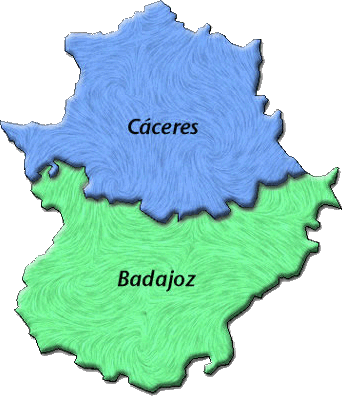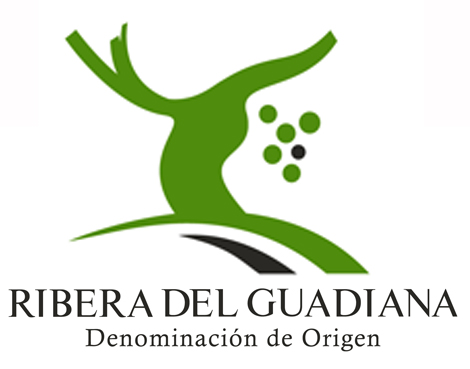Extremadura DOs

Extremadura is an autonomous community located in the west of Spain, bordering with Portugal. Its designation of origin is DO Ribera del Guadiana, which spans most of Extremadura. As with most of Spain, Extremadura wine history goes back to the Romans, or maybe even earlier. The first testimony of wine in Extremadura comes from a document which explains its uses in funerals around the 550 b.C., and when Plasencia was founded at the end of the 12th century, 30 out of 700 articles in the Plasencia Jurisdiction related to wine, which denotes its importance.
The vineyards in Extremadura begin an important expansion around the beginning of the 17th century, and made great benefits until three different plagues ravaged the vineyards: Powdery mildew (1.845), phylloxera (1.868) and mildew (1.878), all imported from America. It wasn't until after the Spanish Civil War that this area started to recover under the hard work of several producers that did everything in their hands to restore the Extremadura vineyards with the latest technologies and discoveries. This has been the Spanish course of action in many of the areas affected by these plagues, not only in Ribera del Guadiana, where the winemakers have done everything possible to help with the takeoff of Spanish wines.
DO Ribera del Guadiana was established in 1999, and this initiated another era in the history of Extremadura wines. Structures were modernized and many investments were made in technology. With this and the help of the wine makers and producers, DO Ribera del Guadiana has become a reference name when Spanish wines are mentioned. Extremadura has become a place to visit because of its wines, but that doesn't mean it lacks entertainment for tourists. The Monfragüe National Park is totally worth a visit if you enjoy nature, and you'll probably find a camping spot near where you can take pleasure in the cool summer nights.
DO (designation of origin) of Extremadura

DO Ribera del Guadinana has six different sub zones of production, each of which produces very different Extremadura wines from each other. When the DO was established in 1999, they weren't concerned about the wines being heterogeneous, but rather about the vines reaching the desired quality to produce wines under the DO. The six sub zones are:
- Tierra de Barros: Found in the middle of the Badajoz province, this area has almost no relief, the soils are highly fertile, and retain water for a long time. The climate is dry with high temperatures in summer. Around 80% of the DO Ribera del Guadiana vineyards are planted in this area.
- Matanegra: Also in the middle of Badajoz, just under Tierra de Barros. Very similar characteristics to the Tierra de Barros sub zone, but the climate is slightly more humid, which delays the harvest for a couple of days.
- Upper Ribera: In the north of the Badajoz province, bordering Cáceres, the quaternary deposits left by the Guadiana have made the soils where the vineyards are planted quite sandy. The vines enjoy a continental climate with a moderate Atlantic influence.
- Lower Ribera: Lower Ribera is located in the west of the Badajoz province, right at the border with Portugal. The Guadiana and its tributaries, in their passing, have given these soils very clayey characteristics. The climate is continental with an Atlantic influence, which means long summers, short and mellow spring and autumn and soft winters.
- Cañamero: This sub zone can be found in the province of Cáceres, in the Sierra de Guadalupe at almost 2800 feet of altitude. The climate is soft without many termic differences.
- Montánchez: This sub zone has a very accidental relief with many hills and small valleys where the vines are planted. The climate is dry and warm in summer, and the winters are quite soft.
The grape varieties allowed in the Extremadura wines of DO Ribera del Guadiana are Alarije, Borba, Cayetana Blanca, Pardina, Viura, Chardonnay, Chelva, Beba de los Santos, Malvar, Parellada, Pedro Ximénez and Verdejo in whites and Garnacha Tinta, Tempranillo, Bobal, Cabernet Sauvignon, Graciano, Mazuela, Merlot, Monastrell and Syrah in reds. You can see that although there are many international vines, there's also a few Spanish classes of grapes. DO Ribera del Guadiana produces reds with a minimum alcohol content of 11%, while whites and rosés have a minimum alcohol content of 10%.
Spanish Wine History
Spanish Wine Regions and DO
Spanish Wine Tours
Top Spanish designations of origin
Best Spanish Wines
Spanish Wine Production
Spanish Wine Types
Spanish Grapes
Spanish Sparkling Wine: Cava
Sherry Wine
Spanish Wine Cocktails
Spanish Wines in the World
Spanish Wine Prizes
Enotourism
Spanish spirits and liquors
Argentina Wines
Chilean Wines
Other sites